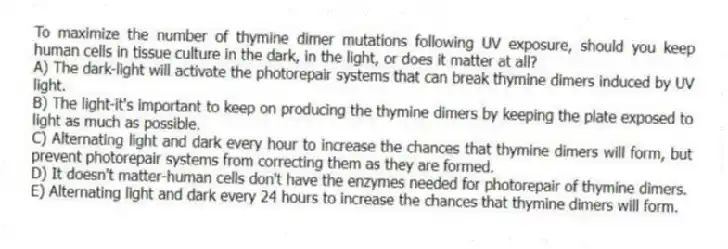
To maximize the number of thymine dimer mutations following UV exposure, should you keep human cells in tissue culture in the dark, in the light, or does it matter at all?
A) The dark-light will activate the photorepair systems that can break thymine dimers induced by UV light.
B) The light-it's important to keep on producing the thymine dimers by keeping the plate exposed to light as much as possible.
C) Alternating light and dark every hour to increase the chances that thymine dimers will form, but prevent photorepair systems from correcting them as they are formed.
D) It doesn't matter-human cells don't have the enzymes needed for photorepair of thymine dimers.
E) Alternating light and dark every 24 hours to increase the chances that thymine dimers will form.
Correct Answer:
Verified
Q36: In conjugation, transformation, or transduction, the recipient
Q37: Gene transfer that requires cell-to-cell contact is
A)
Q38: A clever technique that streamlines the identification
Q39: The diploid character of eukaryotic cells may
Q40: In conjugation the donor cell is recognized
Q42: Double-stranded DNA enters the recipient cell during
Q43: Transposons may leave a cell by incorporating
Q44: DNA is protected from restriction enzymes by
Q45: Each gene mutates at a characteristic frequency.
Q46: Mutations are likely to persist after SOS
Unlock this Answer For Free Now!
View this answer and more for free by performing one of the following actions

Scan the QR code to install the App and get 2 free unlocks

Unlock quizzes for free by uploading documents